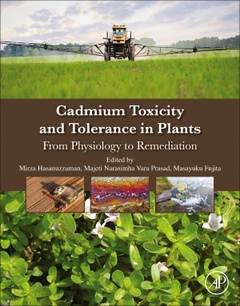Description
Cadmium Toxicity and Tolerance in Plants
From Physiology to Remediation
Coordinators: Hasanuzzaman Mirza, Prasad Majeti Narasimha Var, Fujita Masayuki
Language: English
Subjects for Cadmium Toxicity and Tolerance in Plants:
Keywords
Abiotic stress; Accumulation; Agricultural waste; Alleviating; Alleviation; Ameliorate; Amendments; Anatomy; Antioxidant system; Antioxidants; Aquatic macrophytes; Aquatic plants; Bioremediation; Brassinosteroids; Cadmium; Cadmium contamination; Cadmium in food; Cadmium stress; Cadmium toxicity; Cd; Cd detoxification; Cd tolerance; Cd toxicity; Cd-stress; Cd-tolerance; Cell death; Cell wall; Crop; Defense mechanisms; DELLA proteins; Drinking water; Ecology; Endophyte; Environment; Estuarine environments; Food chain; Fungal symbionts; Gene expression; Gibberellic acid; Grain mineral status; H2O2; Halophytes; Heavy metal; Heavy metals; Herb; Herbaceous plant; Histochemical; Indicators; Industrial waste; Ion uptake; Legume; Localization; Macronutrients; Management; Mechanisms; Metal tolerance; Metal transporters; Metal uptake; Metal-binding ligands; Microbe-assisted phytoremediation; Microbes; Micronutrients; Mineral elements; Morphological; Nitric oxide; Nitrosative; Nutrient imbalance; Nutrient uptake; Oxidative stress; PGPB; pH changes; Photosynthetic apparatus; Physiological; Phytochelatin; Phytochelatin synthase; Phytochelatins; Phytoextraction; Phyto-extraction; Phytofiltration; Phytohormones; Phytoremediation; Phytosequestration; Phytostabilization; Plant; Plant-Cd interactions; Plants; Reactive oxygen species; RNS; ROS; Salicylic acid; Signaling; Soil; Soil and water contamination; Soil contamination; Soil deterioration; Solanum nigrum L; Stream contamination; Stress alleviation; Sustainable; Tolerance; Tolerance mechanism; Toxicity; Trace metals contamination; Translocation; Urban health; Water stress
619 p. · 15x22.8 cm · Paperback
Description
/li>Contents
/li>Readership
/li>Biography
/li>Comment
/li>
Cadmium Toxicity and Tolerance in Plants: From Physiology to Remediation presents a single research resource on the latest in cadmium toxicity and tolerance in plants. The book covers many important areas, including means of Cd reduction, from plant adaptation, including antioxidant defense, active excretion and chelation, to phytoextraction, rhizo filtration, phytodegradation, and much more. In addition, it explores important insights into the physiological and molecular mechanisms of Cd uptake and transport and presents options for improving resistance to Cd stresses. It will be ideal for both researchers and students working on cadmium pollution, plant responses and related fields of environmental contamination and toxicology.
1. Cadmium toxicity and tolerance in plants – An Overview 2. Cadmium toxicity and tolerance in vascular plants - Micro- and phytobiome approach 3. Morphological and physiological responses of plants to cadmium toxicity 4. Adaptive and tolerance mechanisms in herbaceous plants exposed to cadmium 5. Cadmium-induced anatomical abnormalities in plants 6. Cadmium contamination in water and soil 7. Environmental hazards of cadmium: Past, present and future 8. Role of phytochelatins in cadmium stress tolerance 9. Cadmium-induced oxidative stress in plants 10. Cadmium-induced oxidative and nitrosative stress in plants 11. Damage and protection of the photosynthetic apparatus under cadmium stress 12. Cadmium-induced imbalance in nutrient and water uptake in plants 13. The effect of Cd stress in mineral nutrient and water uptake 14. Role of Salicylic acid in mitigating cadmium toxicity in plants 15. Mitigating cadmium toxicity in plants by phytohormones 16. Use of fungi in mitigating cadmium toxicity in plants 17. Microbe-mediated mitigation of cadmium toxicity in plants 18. Use of Solanum nigrum as a potential hyper-accumulator to remediate cadmium contaminated soils 19. Phytoremediation of cadmium contaminated soils by using Sulla coronaria inoculated by efficient and cadmium resistant plant growth promoting bacteria 20. Phytoremediation of cadmium polluted water/sediment by aquatic macrophytes; role of plant-induced pH changes 21. Phytoremediation of cadmium contaminated soils and water 22. Aquatic macrophytes for the remediation of cadmium contaminated sites
Graduate (M.S. and PhD) Students, faculty and researchers in the field of Plant Science, Agriculture, Agronomy, Soil Science, Agricultural Chemistry, Biochemistry, Molecular Biology and Environmental Science
Majeti Narasimha Vara Prasad is an emeritus professor in the School of Sciences at the University of Hyderabad, Hyderabad, India. He also taught at the North Eastern Hill University, Shillong, India. He has made significant contributions to the field of plant-metal interactions, bioremediation, and bioeconomy. He has also published over 210 research articles in peer-reviewed journals with Google Scholar h-index of 61. He is the author, co-author, editor and co-editor of several books by leading international publishers.
Dr. Masayuki Fujita is a Professor in the Department of Plant Science, Faculty of Agriculture, Kagawa University, Kagawa, Japan. He received his B.Sc. in Chemistry from Shizuoka University, Shizuoka, and his M.Agr. and Ph.D. in Plant Biochemistry from Nagoya University, Nagoya, Japan. His research interests include physiological, biochemical and molecular biological responses based on secondary metabolism in plants under biotic (pathogenic fungal infection) and abiotic (salinity, drought, extreme temperatures and heavy metals) stresses; phytoalexin, cytochrome P-450, glutathione S-transferase, phytochelatin and redox reaction and antioxidants. He has over 150 peer-reviewed publications and has multiple books.
- Includes all aspects of cadmium toxicity and tolerance in plants
- Provides a comprehensive overview of advances in cadmium toxicity, tolerance and adaptation in plants
- Elaborates on the advancement of eco-friendly techniques for cadmium remediation from soil and water
- Provides real-world, application focused techniques
These books may interest you

Plant-Metal Interactions 232.09 €



